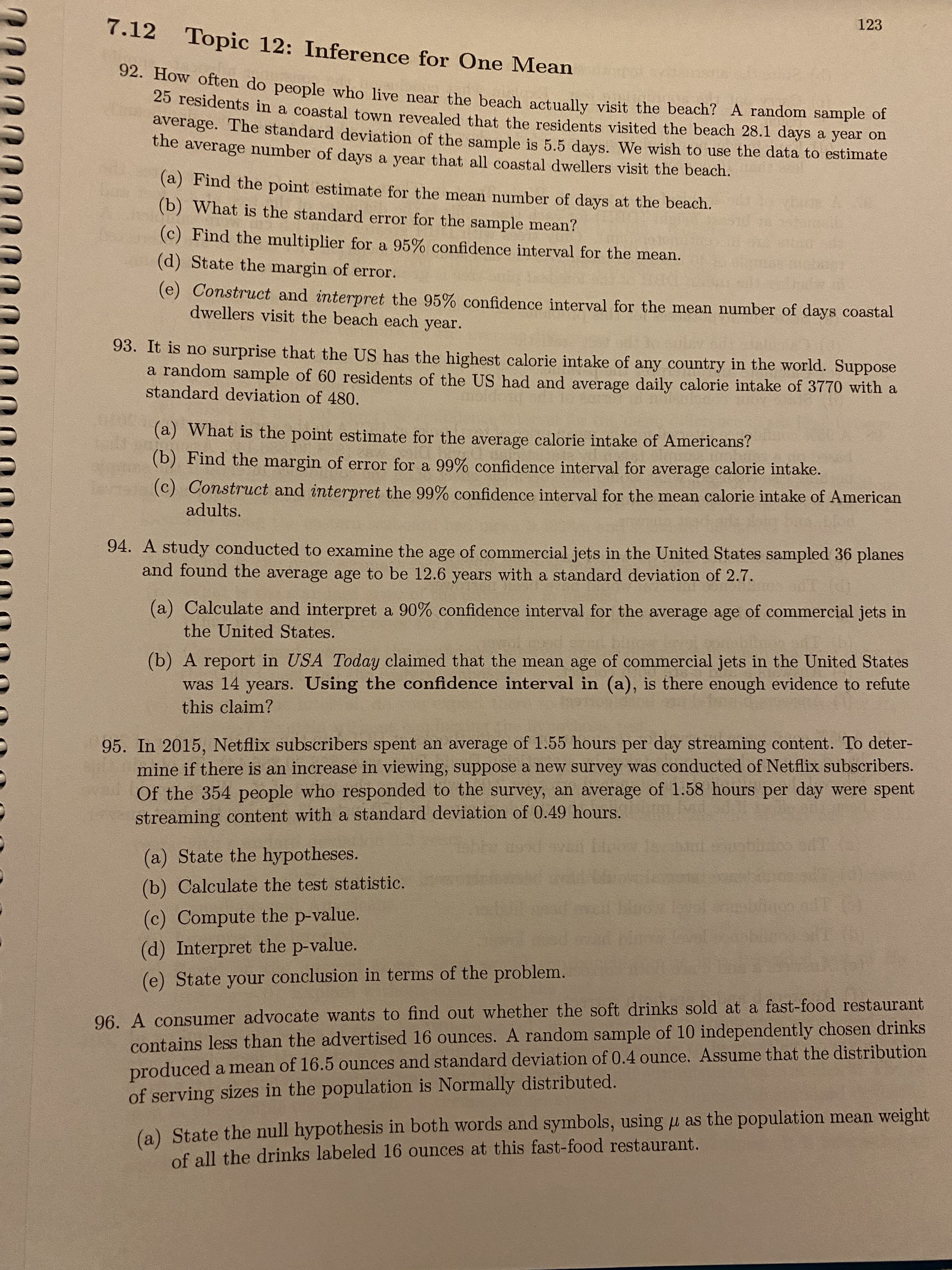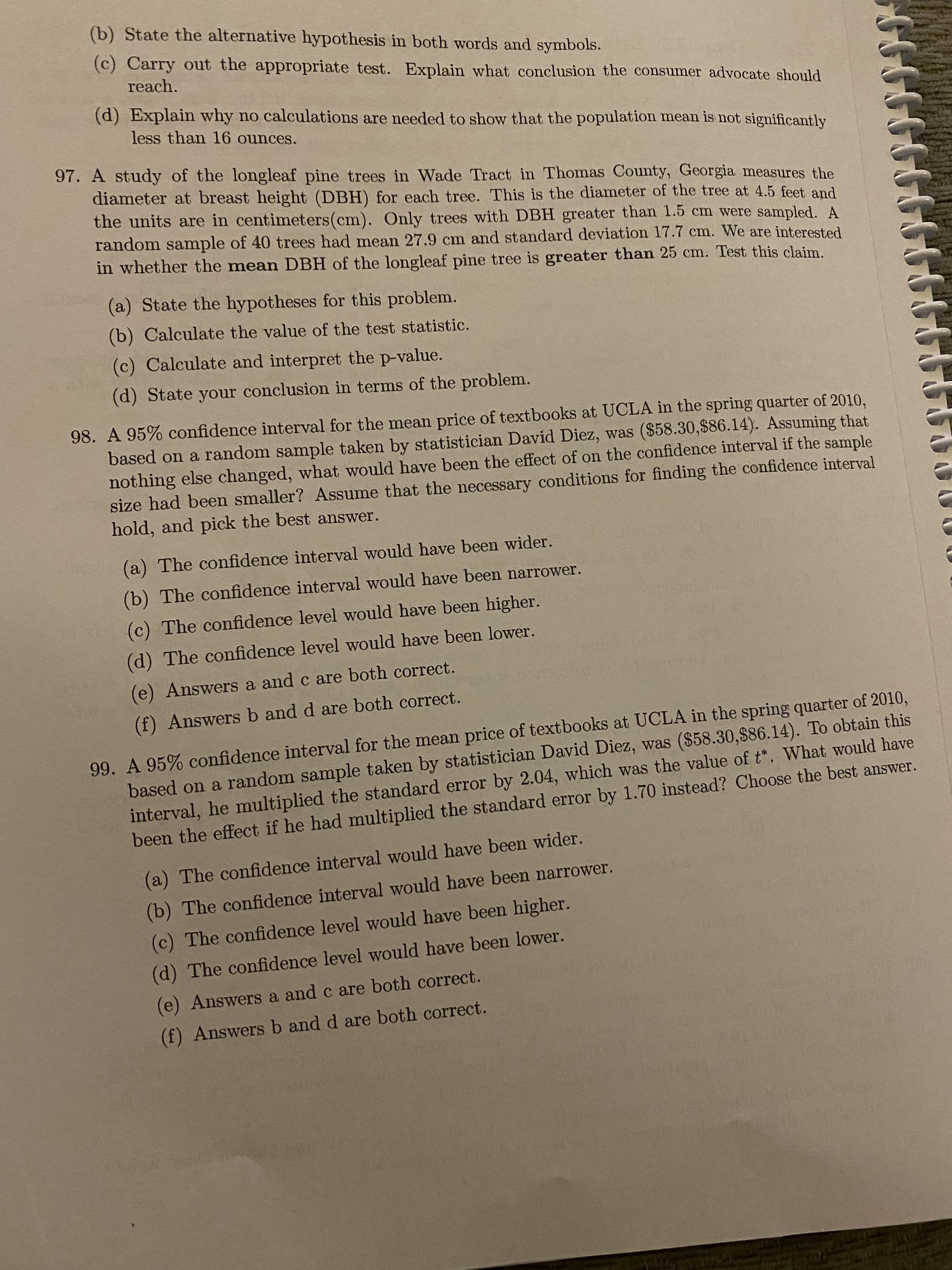7.12 Topic 12: Inference for One Mean 123 92. How often do people who live near the beach actually visit the beach? A random sample of 25 residents in a coastal town revealed that the residents visited the beach 28.1 days a year on average. The standard deviation of the sample is 5.5 days. We wish to use the data to estimate the average number of days a year that all coastal dwellers visit the beach. (a) Find the point estimate for the mean number of days at the beach. (b) What is the standard error for the sample mean? (c) Find the multiplier for a 95% confidence interval for the mean. (d) State the margin of error. (e) Construct and interpret the 95% confidence interval for the mean number of days coastal dwellers visit the beach each year. 93. It is no surprise that the US has the highest calorie intake of any country in the world. Suppose a random sample of 60 residents of the US had and average daily calorie intake of 3770 with a standard deviation of 480. (a) What is the point estimate for the average calorie intake of Americans? (b) Find the margin of error for a 99% confidence interval for average calorie intake. (c) Construct and interpret the 99% confidence interval for the mean calorie intake of American adults. 94. A study conducted to examine the age of commercial jets in the United States sampled 36 planes and found the average age to be 12.6 years with a standard deviation of 2.7. (a) Calculate and interpret a 90% confidence interval for the average age of commercial jets in the United States. (b) A report in USA Today claimed that the mean age of commercial jets in the United States was 14 years. Using the confidence interval in (a), is there enough evidence to refute this claim? 95. In 2015, Netflix subscribers spent an average of 1.55 hours per day streaming content. To deter- mine if there is an increase in viewing, suppose a new survey was conducted of Netflix subscribers. Of the 354 people who responded to the survey, an average of 1.58 hours per day were spent streaming content with a standard deviation of 0.49 hours. (a) State the hypotheses. (b) Calculate the test statistic. (c) Compute the p-value. (d) Interpret the p-value. (e) State your conclusion in terms of the problem. 96. A consumer advocate wants to find out whether the soft drinks sold at a fast-food restaurant contains less than the advertised 16 ounces. A random sample of 10 independently chosen drinks produced a mean of 16.5 ounces and standard deviation of 0.4 ounce. Assume that the distribution of serving sizes in the population is Normally distributed. (a) State the null hypothesis in both words and symbols, using µ as the population mean weight of all the drinks labeled 16 ounces at this fast-food restaurant. (b) State the alternative hypothesis in both words and symbols. (c) Carry out the appropriate test. Explain what conclusion the consumer advocate should reach. (d) Explain why no calculations are needed to show that the population mean is not significantly less than 16 ounces. 97. A study of the longleaf pine trees in Wade Tract in Thomas County, Georgia measures the diameter at breast height (DBH) for each tree. This is the diameter of the tree at 4.5 feet and the units are in centimeters(cm). Only trees with DBH greater than 1.5 cm were sampled. A random sample of 40 trees had mean 27.9 cm and standard deviation 17.7 cm. We are interested in whether the mean DBH of the longleaf pine tree is greater than 25 cm. Test this claim. (a) State the hypotheses for this problem. (b) Calculate the value of the test statistic. (c) Calculate and interpret the p-value. (d) State your conclusion in terms of the problem. 98. A 95% confidence interval for the mean price of textbooks at UCLA in the spring quarter of 2010, based on a random sample taken by statistician David Diez, was ($58.30,$86.14). Assuming that nothing else changed, what would have been the effect of on the confidence interval if the sample size had been smaller? Assume that the necessary conditions for finding the confidence interval hold, and pick the best answer. (a) The confidence interval would have been wider. (b) The confidence interval would have been narrower. (c) The confidence level would have been higher. (d) The confidence level would have been lower. (e) Answers a and c are both correct. (f) Answers b and d are both correct. 99. A 95% confidence interval for the mean price of textbooks at UCLA in the spring quarter of 2010, based on a random sample taken by statistician David Diez, was ($58.30,$86.14). To obtain this interval, he multiplied the standard error by 2.04, which was the value of t*. What would have been the effect if he had multiplied the standard error by 1.70 instead? Choose the best answer. (a) The confidence interval would have been wider. (b) The confidence interval would have been narrower. (c) The confidence level would have been higher. (d) The confidence level would have been lower. (e) Answers a and c are both correct. (f) Answers b and d are both correct.
Permutations and Combinations
If there are 5 dishes, they can be relished in any order at a time. In permutation, it should be in a particular order. In combination, the order does not matter. Take 3 letters a, b, and c. The possible ways of pairing any two letters are ab, bc, ac, ba, cb and ca. It is in a particular order. So, this can be called the permutation of a, b, and c. But if the order does not matter then ab is the same as ba. Similarly, bc is the same as cb and ac is the same as ca. Here the list has ab, bc, and ac alone. This can be called the combination of a, b, and c.
Counting Theory
The fundamental counting principle is a rule that is used to count the total number of possible outcomes in a given situation.
Question 96 parts A and B


Trending now
This is a popular solution!
Step by step
Solved in 2 steps


